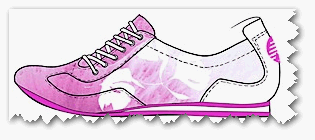Branson was charming and very sharp, as one might expect from his serial business successes. Rather than just a greedy mega-money maker, he came off as a human being, and reminded me of the late Randy Pausch in his advice to "have fun, or find something else to do." His approach to business showed him to be a design thinker from the get-go: His prime advice was to talk to customers and do a ton of research before you ever start making anything. And that the details will kill you: If your airplane seat is second most comfortable, you lost your edge. Hey, let's have standup bars so people can stretch their legs on long flights. Think differently, and solve real problems no one else has tackled!

Then we met designers from New Balance. Jon Hirschtick, a founder of SolidWorks, was shown on video interviewing them at the office first. I was amused by his physical dismissal of the pre-CAD design - he pushed it behind them, visibly, and wanted to get to the CAD part. Makes sense for a guy from a CAD company, but it's not the reality of the design process for the customers.
They showed many iterations with industrial designers sketching the soles and talked about "capturing the designer's vision" in the CAD tool - because that vision is driving their design. It's not the CAD tool or what's possible in it that's driving the product design! Few of their industrial designers use SolidWorks, they use Illustrator--noted by the Sony Ericsson manager up next to be "at least as complicated as SolidWorks if not more" (I say, YES - CAD manufacturers need to comprehend that other tools are professional caliber, too, and also quite complex). New Balance designers were shown drawing by hand on the interview video, as well.

CAD is the "middle part" of their design process. We saw nice rounds of 3D printing, and then an excellent example of making a mold in-house for a real prototype sole to glue onto the bottom of another shoe for field trials (see smooth-on.com).
The physical prototype on the shoe bottom was the "end" of that interview, but I shook my head sadly. The design process isn't over: They're field testing it now! There's a whole range of feedback to process, and design revisions to be made, based on how it feels to walk on! The design manager himself was wearing prototype soles on his feet during his presentation.
Oh, the frustration of getting the truncated design process, to focus only on CAD. Design is computer-aided, not computer-exclusive.

Then came Sony Ericsson. SE works hard to stay competitive in a crowded mobile market. In keeping with Branson's advice, they do a lot of research up front, and employ more cultural and social anthropology approaches than most companies. They look at consumer and design trends or "tendencies," to try to predict what will resonate in 2 years, to keep ahead. (Hirschtick acknowledged this was "a great model for all of us.")
Again, SE design starts in 2D with sketches and Illustrator. About half of their industrial designers want 3D CAD in hand, the others use other tools to express their vision. Their prototyping works the way software prototyping should, using less detail and fidelity initially, to get the egonomics and scale right. He talked about a "form language" they are trying to express first. The design teams produces product animations early in the process, to show to customers for input and feedback, well before development.
Like (most?) other designers, when asked what their biggest challenge is, they said, "Internal politics." Apart from politics, the other challenge cited was "staying fresh." Sometimes it pays to go off on a "no rules, no assumptions" design kick and get crazy. Question what makes the front different from the back of the phone, and why? Why should we sell through normal channels? What if we didn't??

Sony Ericsson wants tools for design that are very accessible, with fewer features for quick and simple use. Again, Photoshop and Illustrator are already more complex than most CAD tools, and industrial designers are experts with them. What I liked about this was the recognition that their design expertise and skill wasn't seen as useless simply because they didn't use CAD: It's the tools that have to speak to the designers better. (And, quite possibly, an employer that could make more time for learning more tools on the job.)
As a software designer who has spent more than the last decade trying to get design pre-coding taken seriously, I could only hope that the owners of software companies in the audience were thinking about how these successful businesses might teach them something. Important points, for me:
- Design requires a lot of customer input up front - take the time to do it, and do it seriously. Consider using skills from anthropology, sociology, or cultural studies while doing this - because those people see things differently. (They might not, for instance, shove the pre-CAD design behind them to get to the CAD part of the company process.)
- Design is iterative, even before coding/modeling: Review ideas, discuss them, and revise the design. For software, this can be a simple as mockups and sketches.
- Prototypes are a part of design, in that they give the designer and team something to feel and play with and revise.
- Prototypes should start low fidelity and get higher fidelity, as the design progresses. This means breaking the problem down into "first part" and "second part" etc. In software design, this is also doable, but rarely done and requires sufficient time and analysis.
- Tools of a variety of types might be wanted and needed. A designer might still be great, even if they don't speak your tool language. Can you tool be made to speak their language? Can you change your process to incorporate other tools and, even better, other voices?
- Good design can save you expensive mistakes - the CAD world has been preaching this for years, but few software companies have gotten it yet. Design it before you code it, if you want quality products.
2 comments :
"Design is computer-aided, not computer-exclusive."
Amen to that sister
continously add new runescape power levelingnegative price factors for rares, which is partly why they haven't been increasing all that much over the runescape accountslast year anymore and perhaps might not do much in the future as well. Plus, there are other factors, like stagnating population runescape powerlevelinggrowth and lower money growth.
Post a Comment